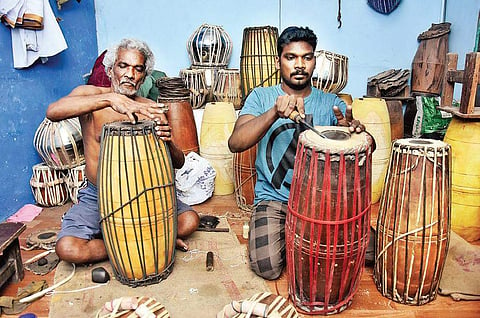

CHENNAI: As you near Mundakanni Amman temple in Mylapore, beats of the mridangam welcome you. If you follow the sound, you reach a narrow passage beside the temple. We walked till the end of the road to find a room where 64-year-old Jesudass and his 30-year-old son, Edwin, were making mridangam and other percussion instruments.
The small room is filled with instruments of different shapes and sizes. On a shelf, arranged neatly, are images of Velankanni Matha and Hindu Gods. Edwin says, “My cousin and I are the fifth-generation mridangam makers.” Edwin’s grandfather’s brother Fernandes, who hailed from Thanjavur, was taught the art of making the instrument by one of the leading mridangam players, Palghat TS Mani Iyer.
“The perfection with which we made the instrument fetched us a lot of customers, especially stalwarts of Carnatic music like Karaikudi Mani, Palghat R Raghu, Umayalpuram Kasiviswanathan Sivaraman and Thanjavur Upendran,” says Jesudass. The Fernandes Award for Excellence was instituted in memory of Fernandes five years ago by The Parivadini, a virtual sabha, and the first award was received by his son F Selvam.
Jesudass and his family shifted to Chennai 30 years ago, at the request of Thanjavur Upendran. “Making a mridangam is an art. You will have to tune the instrument just by hitting. The instrument is customised to the artiste as each one plays at a different pitch. The skin that we use produces different sounds. We buy cow skins from Thanjavur. My father and his brothers have tried with skins of cows from Andhra Pradesh and Mumbai, but it did not produce the same kind of sound,” explains Edwin.
Jesudass further explains that the right side of the instrument should contain three layers of skin — the first two layers made of cow skin and the third one with buffalo skin. Similarly, on the left side, a layer of buffalo skin and goatskin are used. The skin is stitched with a thread made of buffalo skin. The body is made of wood from the jackfruit tree. An important add-on is a black stone (kittangal) from Cauvery river bed.
“Those stones have a kind of magnetic power to perfect the tune. We powder the stone and make it into a paste with boiled rice to make the perfect circle in the centre. The same stone is also used to rub over the skin until the rhythm is perfected,” says Edwin. Edwin’s family is now spread across the state and 70 per cent of the mridangam makers are related to them. They also make other instruments like tabla and timpani on request. Do they play the instrument? Edwin says, “We are the makers... We are born to be behind the success of mridangam players. I’ll teach this profession to my sons so that the legacy continues.”
A family business
Edwin’s family is now spread across the state and 70 per cent of the mridangam makers are related to them. They also make other instruments like tabla and timpani on request.